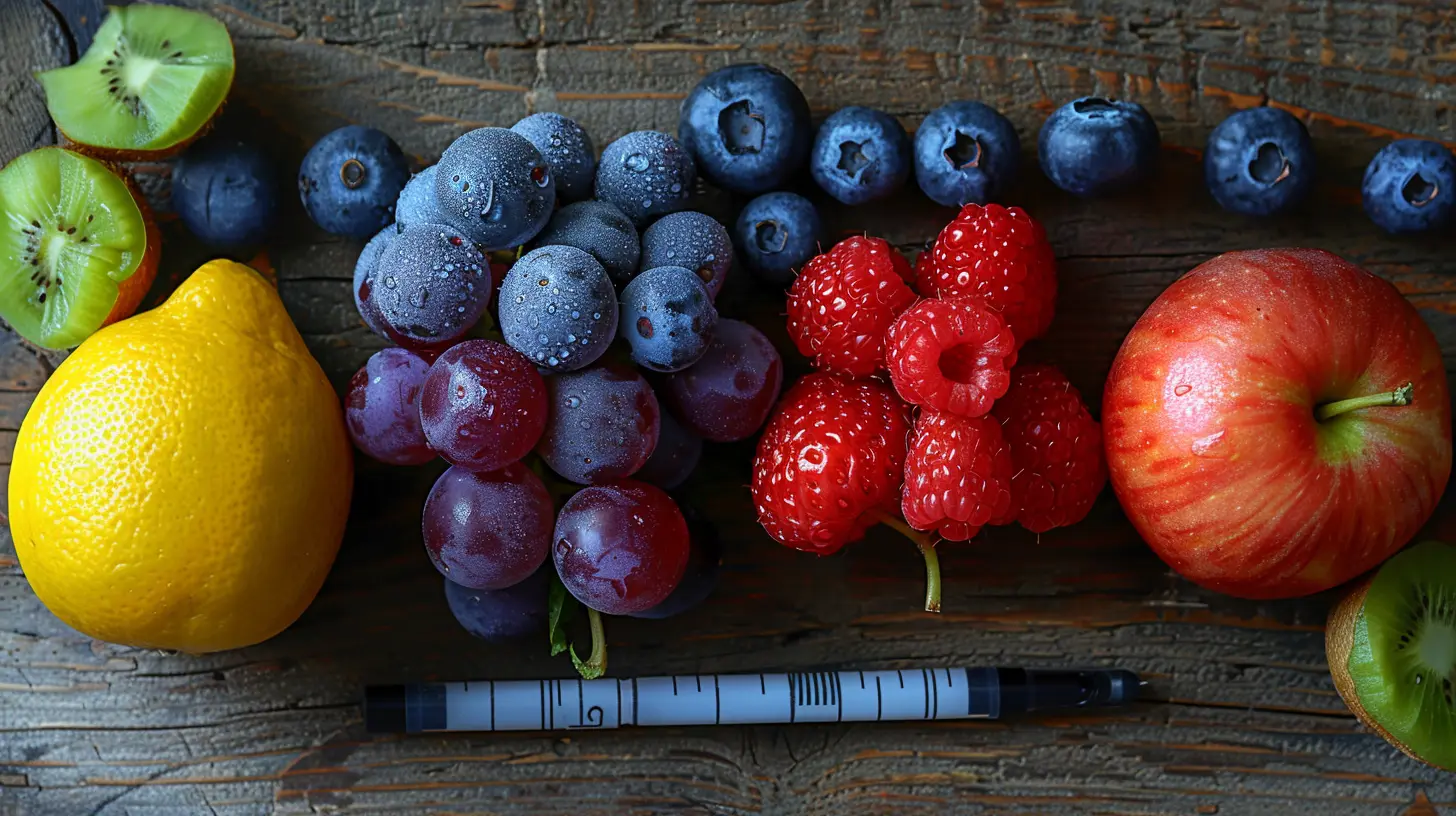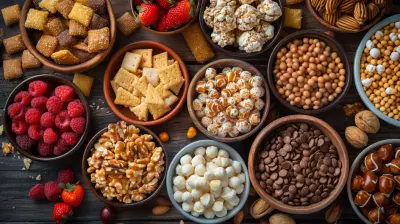Managing Your Blood Sugar Levels Through Smart Nutrition
28 December 2024
Let’s be real—managing blood sugar levels can feel overwhelming, right? Whether you’ve been recently diagnosed with diabetes, prediabetes, or are just trying to dodge a family history of high blood sugar, it can seem like a daunting balancing act. But here’s the good news: managing your blood sugar isn’t about deprivation. It’s about making smart, informed food choices. It’s like having the right tools for a DIY project—you’ll get the job done with fewer headaches.
In this guide, we’re breaking it down step by step. By the end of this article, you’ll know how simple changes in your diet can help keep your blood sugar on an even keel. Ready to dive in? Let’s do this.
Why Is Blood Sugar Management Important?
Let’s start with the basics. Your blood sugar (or glucose) gives your body energy—it’s fuel for your cells. When it’s balanced, you feel energized and focused. But when it swings wildly—think peaks and valleys—it can leave you feeling sluggish, cranky, or even lightheaded. Long-term, poorly managed blood sugar can increase your risk of serious health issues like heart disease, kidney problems, and nerve damage. Yikes, right?The goal is to keep your blood sugar in a healthy range. And nutrition is your secret weapon.
The Connection Between Nutrition and Blood Sugar
Here’s the deal: the food you eat directly impacts your blood sugar levels. When you chow down on carbs, your body breaks them down into glucose, which enters your bloodstream. Your pancreas then releases insulin, a hormone that helps shuttle that glucose into your cells to be used for energy.If you eat too many carbs or sugar-laden foods, your blood sugar spikes—and over time, this can wear out your body’s insulin response. On the flip side, skipping meals or not eating enough can cause your blood sugar to crash. So, it’s all about finding that sweet spot (pun intended!).
Smart Nutrition Tips for Managing Blood Sugar
Now for the real meat and potatoes (well, maybe without the potatoes). Here are some practical, science-backed tips to help you keep your blood sugar steady and your health in check.1. Balance Your Plate Like a Pro
Ever heard about the "plate method"? It’s an absolute game-changer. Picture your plate divided into three sections:- Fill half of your plate with non-starchy veggies (like broccoli, spinach, or bell peppers). These are low in carbs but packed with fiber, which helps control blood sugar.
- Reserve a quarter of your plate for lean protein (think chicken, fish, tofu, or eggs). Proteins keep you fuller longer and slow down sugar absorption.
- Use the last quarter of your plate for whole grains or starchy veggies (like quinoa, sweet potatoes, or brown rice). These carbs digest slower, preventing sugar spikes.
This simple formula keeps meals balanced and blood sugar-friendly.
2. Don’t Skip Fiber—It’s Your Blood Sugar BFF
Fiber is like the unsung hero of blood sugar control. It slows down how quickly your body digests and absorbs carbs, preventing those annoying sugar spikes. Aim for about 25–38 grams of fiber per day. Load up on:- Legumes (like lentils and chickpeas)
- Whole grains (oats, quinoa, barley)
- Fruits (berries are A+ for this!)
- Veggies (think kale, carrots, and Brussels sprouts)
Fiber isn’t just for, well, keeping things moving—it’s a key player in keeping your blood sugar on point.
3. Say Hello to Healthy Fats
Fats have gotten a bad rap over the years, but not all fats are created equal. Healthy fats can actually help manage blood sugar by slowing digestion and keeping you satisfied. Add these to your grocery list:- Avocados
- Nuts and seeds (walnuts, chia seeds, and flaxseeds are top-notch options)
- Olive oil
- Fatty fish (like salmon and mackerel)
Just remember: moderation is key here. Even healthy fats are calorie-dense, so don’t go overboard.
4. Watch Out for Hidden Sugars
Sugar is sneaky—it hides in foods you wouldn’t even suspect. Think ketchup, salad dressings, and flavored yogurts. Reading food labels is your armor. Look for words like “high-fructose corn syrup,” “cane sugar,” or anything ending in “-ose.” Wondering how much sugar is too much? The American Heart Association suggests no more than 36 grams per day for men and 25 grams for women. That’s about 6 teaspoons—less than you’d think!5. Eat Smaller, Frequent Meals
Ever feel “hangry” halfway through the day? Skipping meals or going too long without eating can make your blood sugar plummet. Instead, aim for smaller, balanced meals every 3 to 4 hours. It helps keep your energy consistent and prevents overeating later. Think of it as fueling a fire—you wouldn’t throw on too much wood at once or let it burn out completely.6. Hydration Is Key
Here’s the tea (or water, more like it): staying hydrated is crucial. Water helps your kidneys flush out excess sugar from your bloodstream. Aim for at least 8 cups per day, and more if you’re active. Swap sugary drinks like soda and juice for water, herbal tea, or sparkling water with a splash of lemon. Your blood sugar will thank you.7. The Magic of Low Glycemic Index Foods
The glycemic index (GI) measures how quickly a food raises your blood sugar. Low-GI foods digest more slowly, keeping your blood sugar nice and steady. Some go-to low-GI options include:- Sweet potatoes instead of white potatoes
- Brown rice or quinoa instead of white rice
- Apples, oranges, and berries instead of bananas or pineapple
Making these swaps? It’s like switching to cruise control for your blood sugar.
Foods to Avoid (or Limit) for Better Blood Sugar
Self-restraint can be tough—we’ve all been there. But cutting back on these blood sugar troublemakers can make a world of difference:- Sugary snacks (think candy, pastries, and soda)
- Refined carbs (white bread, white rice, and most packaged snacks)
- Trans fats (often lurking in fried and processed foods)
- Alcohol (it can mess up blood sugar control AND your sleep)
The goal isn’t to banish these completely; just enjoy them in moderation. Life’s too short to never have a cookie—just pair it with a handful of nuts to blunt the sugar effect.
Quick Lifestyle Tips to Support Blood Sugar Management
Nutrition is the MVP here, but it’s not the only thing that matters. Pair your smart eating habits with these healthy lifestyle tweaks:- Move more: Even a 10-minute walk after meals can help lower blood sugar.
- Prioritize sleep: Sleep deprivation wreaks havoc on blood sugar levels.
- Manage stress: Chronic stress can increase your blood sugar—try mindfulness exercises, yoga, or even just deep breathing.
- Monitor your levels: Keep tabs on your blood sugar to see what works for you—everyone’s different!
Making It Sustainable
Let’s be honest, sticking to a blood sugar-friendly diet long-term is all about balance. Nobody’s perfect, and you don’t have to be either. The key is consistency, not perfection. Slip-ups happen—it’s what you do next that counts. Just dust yourself off and get back on track.Think of this journey like planting a garden. It takes time, effort, and patience—but once those habits grow, they’ll nourish you for years to come.
Final Thoughts
Managing your blood sugar doesn’t need to feel like climbing Mount Everest. With a few tweaks to your diet and a better understanding of how food impacts your body, you’ll be well on your way to a healthier, more energetic life. Remember, it’s not about what you can’t have—it’s about filling your plate (and your life) with foods that love you back.You’ve got this. Start small, keep it simple, and give yourself grace as you find what works best for you.
all images in this post were generated using AI tools
Category:
NutritionAuthor:

Jackson Mahoney
Discussion
rate this article
13 comments
Quincy Simmons
Thank you for this insightful article! It’s empowering to learn how smart nutrition can play a pivotal role in managing blood sugar levels. Your tips inspire a healthier, more mindful approach to eating.
April 5, 2025 at 3:49 AM

Jackson Mahoney
Thank you for your kind words! I'm glad you found the article insightful and empowering. Wishing you all the best on your journey to mindful eating!
Thalyn Kelly
Take charge of your health—smart nutrition isn’t just an option; it's essential for mastering your blood sugar levels and vitality!
March 30, 2025 at 3:14 PM

Jackson Mahoney
Thank you for emphasizing the importance of nutrition! Taking charge of our health is indeed vital for effective blood sugar management.
Vanta Carrillo
Who needs a crystal ball when you have kale and quinoa? Managing blood sugar can be as easy as pie—healthy pie, of course! With a sprinkle of smart nutrition and a dash of moderation, you’ll keep those sugar levels in check and still have room for dessert. Balance is key!
February 7, 2025 at 4:56 PM

Jackson Mahoney
Absolutely! Balance and smart nutrition are essential for managing blood sugar. Enjoying healthy foods like kale and quinoa can make a delicious difference. Thanks for sharing!
Flynn Dodson
Fuel wisely; your health deserves nothing less!
January 31, 2025 at 4:49 PM

Jackson Mahoney
Thank you for your insightful comment! Prioritizing smart nutrition is indeed essential for maintaining healthy blood sugar levels.
Reina Gibson
Stop settling for mediocrity in your health! Smart nutrition isn't just a choice; it's a commitment. Elevate your blood sugar management game, fuel your body right, and reclaim your vitality without excuses!
January 26, 2025 at 4:46 PM

Jackson Mahoney
Thank you for your enthusiastic reminder! Committing to smart nutrition is key to effective blood sugar management and overall vitality. Let’s elevate our health together!
Orionis Mason
Smart nutrition empowers effective blood sugar management, promoting overall health and preventing chronic conditions effortlessly.
January 20, 2025 at 4:57 PM

Jackson Mahoney
Thank you for your insightful comment! Smart nutrition truly plays a crucial role in effective blood sugar management and overall well-being.
Hesper McQuade
Unlock the secrets of balance: can the right foods reveal the hidden truths of your blood sugar journey?
January 15, 2025 at 4:28 PM

Jackson Mahoney
Absolutely! The right foods can significantly impact your blood sugar levels, offering insights into your body's unique responses and helping you achieve better balance.
Tenley Strickland
Great tips! It's amazing how smart nutrition can really make a difference in managing blood sugar levels. Excited to implement these strategies in my daily routine!
January 9, 2025 at 3:19 PM

Jackson Mahoney
Thank you! I'm glad you found the tips helpful—best of luck with your new routine!
Vex Hahn
This article effectively highlights the crucial link between smart nutrition and blood sugar management. Emphasizing whole foods, balanced meals, and mindful eating provides practical strategies for readers. By understanding the glycemic impact of foods, individuals can make informed choices, ultimately promoting better health outcomes and enhanced well-being.
January 3, 2025 at 5:56 AM

Jackson Mahoney
Thank you for your insightful feedback! I'm glad you found the link between smart nutrition and blood sugar management compelling. Promoting informed food choices is key to better health!
Holden Romero
Managing blood sugar through smart nutrition is like hosting a party: invite the right foods, kick out the sugar crashers, and don’t forget to dance with fibers! Let’s toast with some leafy greens and keep those glucose levels as happy as a kid in a candy store—minus the candy!
December 30, 2024 at 4:43 AM

Jackson Mahoney
Absolutely love the party analogy! Smart nutrition truly makes all the difference in keeping blood sugar levels stable and happy. Cheers to healthy choices! 🎉🥗
Tracie McGonagle
Great article! Understanding how nutrition affects blood sugar is so important. Small changes can make a big difference—definitely feeling inspired to make healthier choices!
December 29, 2024 at 4:15 AM

Jackson Mahoney
Thank you! I'm glad you found it inspiring. Small changes can truly lead to significant improvements in blood sugar management. Keep up the great work!
Colton Smith
Smart nutrition is key to mastering blood sugar levels. Prioritize whole foods, balanced meals, and mindful eating for optimal health and energy throughout the day!
December 28, 2024 at 6:02 PM

Jackson Mahoney
Absolutely! Smart nutrition plays a crucial role in managing blood sugar levels. Focusing on whole foods and balanced meals can significantly enhance your energy and overall health. Thank you for highlighting this important aspect!
Beatrice King
This article effectively emphasizes the critical role nutrition plays in managing blood sugar levels. By focusing on whole foods, balanced macronutrients, and mindful eating, individuals can empower themselves to make informed dietary choices. The practical tips provided are invaluable for fostering long-term health and preventing complications.
December 28, 2024 at 5:02 AM

Jackson Mahoney
Thank you for your insightful comment! I'm glad you found the article helpful in highlighting the importance of nutrition for managing blood sugar levels. Empowering individuals with practical tips is key to promoting long-term health.
MORE POSTS

Creating a Calm Corner: Designing a Space for Relaxation

The Surprising Benefits of Chewing Certain Vegetables for Strong Teeth

The Intersection of Functional Medicine and Epigenetics in Personalized Health

Boost Your Immunity With These Nutrient-Packed Snacks

How to Support Your Immune System Through Hormonal Shifts

Low-Calorie Snacks That Actually Taste Amazing

How Sleep Ties Into Better Gut Function

The Role of Sleep Hygiene in Long-Term Stress Management

Can Cholesterol Levels Fluctuate? Here’s What You Need to Know